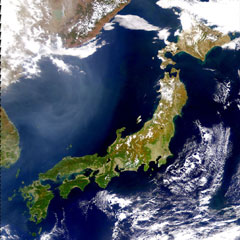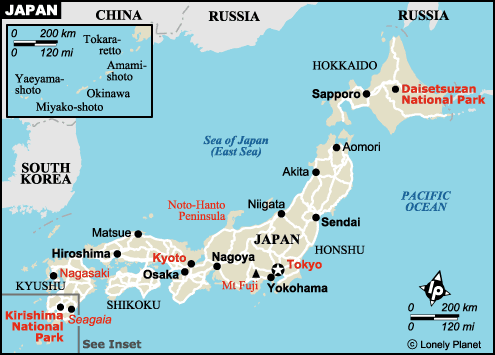
History
The history of Japan is very long: it begins around 3,000 B.C.! The first emperor of Japan, Emperor Jimmu-tenno, ascended to the throne around 660 B.C. Japan's emperors were very powerful, but in the beginning of the 20th century the power of government began to shift from the emperor to the parliament. At the end of the second world war, with the droppings of the two atomic bombs on Nagasaki and Hiroshima, Japan was devastated and politically and economically ruined. Japan's new constitution went into effect in 1947, in which the emperor was left with no power and the military of Japan was severely weakened. Japan has been a democracy ever since. Since the second world war Japan has grown economically in a remarkable way. Japan's economy rivals that of any other country in the world today.
For more information about the history of Japan, you are encouraged to surf to the website of
the Japanese Historical Society. A very short description of Japanese history, as well as in-depth information can be found there.
On the left, a timeline of the development of the current Chinese pictograph for 'horse' is shown. Japan has 'borrowed' many characters from China, including this character for 'horse'. In this case, the etymology of the pictograph is quite clear and helps in remembering the meaning of the pictograph. Unfortunately, this is not always the case. James W. Heisig has thought up wonderful stories for a lot of kanji pictographs of the Japanese language) in order to be able to remember them. A large part of one of his books can be found here: Remembering the Kanji I (pdf)

November in Japan
The Shouraizou study tour will take place in november 2004. To a Dutchman, this may sound weird, because of the cold weather and heavy showers in that period of the year. We think though that November is just the right time to visit Japan.
Because of the shape and orientation of Japan on the globe, it extends over a large range of latitudes: from 45° N to 26° N. Because of the large latitude range, the north and south of Japan have very different climates. Compared to the Netherlands (ranging from 54°N to 51°N), Japan is nearer to the equator and has a bit more comfortable temperatures in the winter (not that much though).
Since most of the industrial activity is on the main island Honshu around Tokyo and Osaka, this is where we will be staying a lot and the latitude of that region (35°N) is about the same as Spain. But don’t be deceived! Because of the very high humidity, summer in Japan is very hot, although you will find airco systems in almost every building. One could say that this makes summer not the best season to visit Japan. According to Lonely Planet: “Autumn (September to November) is a great time to travel: the temperatures are pleasant, and the autumn colours in the countryside are fantastic.” Most of the rain will fall in September with the occasional typhoon (!), but in November the days become clearer.
So don’t expect to return from the study-trip with a dark tan, but you don’t have to fear to be washed away either.
In November, the national holidays are Culture Day on November 3rd and Labor Thanksgiving Day on November 23rd. When a national holiday falls on a Sunday, the following Monday becomes a holiday. But alas, in 2004, neither November 3rd or 23rd fall on a Sunday.



